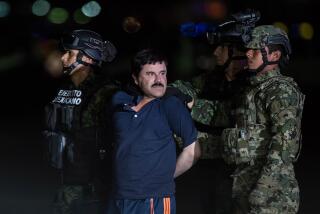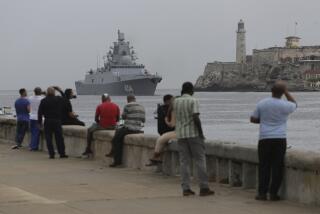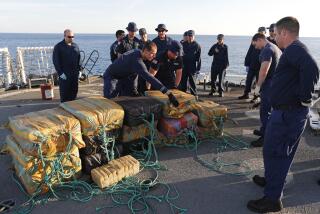Drug traffickers use submersibles to ferry narcotics
CALI, COLOMBIA — It was on a routine patrol that the Colombian coast guard stumbled upon an eerie outpost amid the mangroves: a mini-shipyard where suspected drug traffickers were building submarines.
Perched on a makeshift wooden dry dock late last month were two 55-foot-long fiberglass vessels, one ready for launch, the other about 70% complete. Each was outfitted with a 350-horsepower Cummins diesel engine and enough fuel capacity to reach the coast of Central America or Mexico, hundreds of miles to the north.
The vessels had cargo space that could fit 5 tons of cocaine, a senior officer with the Colombian coast guard’s Pacific command said in an interview.
The design featured tubing for air, crude conning towers and cramped bunk space for a crew of four, he added.
Over the last two years, Colombian authorities and the U.S. Coast Guard and Navy have seized 13 submarine-like vessels outfitted for drug running. The five seized by American authorities were en route to Mexico or Central America, each loaded with 3 to 5 tons of cocaine.
The seizures point to a security threat that goes beyond drug trafficking. Many law enforcement officials are concerned that U.S. ports and shorelines could be vulnerable to terrorist attacks using such crudely built submarines.
“There could be 5 tons of anything on board these things,” said a senior U.S. military official involved in the war on drugs.
Added a senior official with the U.S. Drug Enforcement Administration in Colombia: “Any viable method to covertly transport large quantities of illicit drugs over long distances such as these [vessels] could conceivably be employed to transport other prohibited materials.”
The boats have become increasingly sophisticated, evolving from huge tubes built to be towed by fishing or cargo boats to self-propelled vessels with ballast systems and communications equipment that leave no wake or radar profile as they glide just below the ocean surface.
The recent discovery in the Pacific Coast estuary about 25 miles south of the port city of Buenaventura reflects drug traffickers’ growing use of such boats in the face of stepped-up operations by Colombian and U.S. anti-drug forces, experts here say.
The subs were probably commissioned by the Revolutionary Armed Forces of Colombia, or FARC, in whose zone of influence the shipyard was situated, according to the officer, who asked not to be identified for security reasons. The FARC is thought to be Colombia’s most powerful drug-trafficking organization.
Military officials here and in the United States say the war on drugs, financed by billions of dollars in U.S. aid, is forcing drug runners to undertake ever more ingenious methods of transporting cocaine from Colombia, which produces about 90% of the drug consumed in the United States.
Proponents insist that the campaign is producing concrete results. They cite a 24% increase in cocaine street prices this year as reported by the White House Office of National Drug Control Policy.
The price bump was caused by the “disruption of cocaine flow,” the office’s director, John P. Walters, wrote in a letter to Rep. J. Dennis Hastert (R-Ill.).
Improved surveillance and intelligence have led to spectacular busts this year, including the seizure last Tuesday in Manzanillo, Mexico, of 23 tons of cocaine hidden in a freight container aboard a Hong Kong-flagged vessel that had stopped in Buenaventura.
The bust “is going to have even more serious impact on cocaine price and purity levels here in the United States,” a senior U.S. congressional aide said Friday.
Meanwhile, critics of the war on drugs warn that the price increase, as in past instances, may prove only temporary.
John Walsh of the Washington Office on Latin America, a watchdog organization, said a 45% price increase in early 2002 was quickly reversed as suppliers adjusted.
Walsh and others say counter-narcotics efforts in Colombia should focus less on interdiction and more on economic alternatives for coca farmers and others caught up in the industry.
In any event, the ever-changing tactics of Colombian drug traffickers targeting the lucrative U.S. market reflect a constant cat-and-mouse game.
“When we adjust to them, they adjust to us,” said Rear Adm. Joseph Nimmich, commander of the Key West, Fla.-based Joint Interagency Task Force South, a multinational force set up to interdict oceangoing drug shipments.
“Their reaction to our greater surveillance and increased interdictions has been these self-propelled submersibles.”
Are drug cartels resorting to submarines out of “desperation or just diversification? It’s a combination of the two, with the greater emphasis on the former,” said Assistant U.S. Atty. Joseph Ruddy, who heads Operation Panama Express, a Tampa, Fla.-based task force. The task force’s interdictions have resulted in more than 1,100 drug traffickers being convicted since 2000.
The boats seized Oct. 28 are submarine-like, but officials here say a more accurate description is “self-propelled semi-submersible” craft because they do not dive and resurface like a true submarine.
Submarines are not new to drug trafficking, only more numerous, if the increase in seizures is any indication.
In what was the most spectacular bust involving a narco-submarine, police in September 2000 raided a warehouse near Bogota, the capital, and found a 100-foot-long submarine that was being built according to Russian plans.
The sub was thought to be a joint venture by Colombian and Russian drug mafias and would have been capable of carrying 10 tons of cocaine per trip had it been completed. Annual Colombian cocaine production is now estimated at 500 to 800 tons.
In 1995, police broke up a deal in which Colombia’s Cali cartel had planned to buy a Russian submarine.
The know-how to build crude “submersibles” is readily available on the Internet and in back issues of Popular Mechanics magazine.
Hobbyists in the United States have formed the Personal Submersibles Organization; they conduct chats on the group’s website, psubs.org, and hold annual meetings.
But the vessels found on Colombia’s Pacific shores last week were built for anything but recreation and certainly not by hobbyists.
The Colombian coast guard official said crew members of a submersible detained this year after their 55-foot vessel sank off the coast of Tumaco, Colombia, told police that they viewed the craft as a death trap but were lured by the $2,000 payment the drug magnates promised to pay them to guide the vessel to Central America.
Asked to describe the men detained, the coast guard official merely said: “Crazy.”
More to Read
Sign up for Essential California
The most important California stories and recommendations in your inbox every morning.
You may occasionally receive promotional content from the Los Angeles Times.










